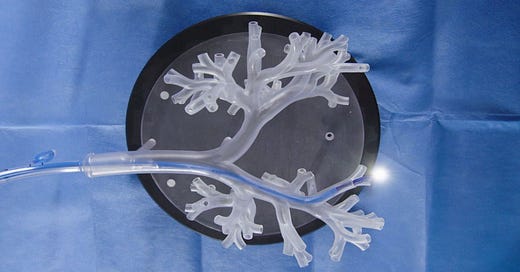Even by Silicon Valley standards, Lux Capital’s investment strategy has always been pretty out there. The venture capital firm started investing in frontier technology right before the dot-com bubble burst. It has bet big on nuclear waste companies, digital health, robotic taxis, 3D printing, medical robotics companies, and autonomous drones.
Today, the ambitious-bordering-on-delusional investing strategy that Lux specializes in is far more popular than it was a decade ago. And the rise of special purpose acquisition companies has made it easier than ever to take future-oriented companies public without needing to worry too much about present cashflows.
But just as that SPAC party was starting to get really fun, the Securities and Exchange Commission threw a spotlight on the listing bonanza, raising questions about what would happen to this new source of capital for ambitious and uncertain technology companies.
Peter Hébert, Lux’s co-founder, has become a SPAC expert. He’s had seven portfolio companies announce that they would go public via a SPAC. On top of that, Lux has a $345 million acquisition company of its own. We spoke at a tough time for many SPACs. Lux portfolio company Desktop Metal is worth $2.8 billion, down 63 percent from its $7.6 billion peak in February. Virgin Galactic, Chamath Palihapitiya’s first SPAC acquisition, is worth $3.7 billion, down 74 percent from its $14 billion peak in February.
But Hébert still believes in SPACs, even if the SEC doesn’t seem to. Over two conversations, Hébert and I talked about how Lux got its start and why he thinks SPACs are a valuable addition to the financial system. He also dished about Amazon’s acquisition of portfolio company Zoox.
Hébert — who worked at Lehman Brothers before co-founding Lux with Josh Wolfe and Robert Paull — is unusual: He’s a financially-minded investor who has spent the last two decades betting on the types of companies that are the hardest to model. Today, Lux is investing out of a $2.5 billion pool of capital, but it took many years for the firm to show its strategy had real promise. Time will tell whether SPACs further validate Lux’s strategy, provide an escape hatch for unproven businesses, or if the SPAC craze ends before much of Lux’s portfolio makes it to the public markets.
If you charted out the firm’s reputation over the years, Hébert says, it would be, “Ignored, obscure, obscure, obscure, and then all of a sudden, there's more significant interest over the last five years. We were either early or wrong 21 years ago — they're probably both the same.”
Lux’s Origin Story
Wolfe, Paull, and Hébert set out to found Lux in 2000 just as the technology world was in a frenzy. “This was decidedly before the dot-com bust, with best laid plans,” Hébert recalls. “It was when aspiration and ambition filled the air.” Then tech stocks collapsed.
“We'd sit in front of a hedge fund manager, describe this vision, and the hedge fund manager would look at us and then they'd look up at the NASDAQ going down 500 points, and they’d say, ‘What are you possibly thinking?’” Hébert says. “We were, in many ways, put in business by an extraordinary human being who changed our personal and professional trajectories: Bill Conway, one of the founders of The Carlyle Group. It was a total serendipitous introduction. We didn't know Bill.”
Conway is still a large investor in Lux’s funds. “Bill to this day remains a very close advisor, a large limited partner of ours across everything that we've done.”
Hébert says the firm’s first major success in deep tech came more than a decade and a half after the firm’s founding. Wolfe had co-founded a nuclear waste disposal company called Kurion. “A lot of people are talking about solar and wind and biofuels,” Hébert remembers. But Lux believed it might take nuclear power to replace coal as a core fuel source. In 2016, international waste management company Veolia bought Kurion for $365 million. Hébert said Lux owned 30% of Kurion and had invested $2 or $3 million in the company. “So that was the first time that I think people thought, wow, you know, some of these obscure areas, deep science can pay off,” Hébert says.
While there were venture capitalists like Chris Dixon and Steve Jurvetson making futuristic bets, many venture capitalists were perfectly happy making a killing in software as a service. “We almost joke internally, we were like The Beverly Hillbillies, no one really cared about the areas that we were investing in,” Hébert says.
Lux portfolio companies sometimes struggled to find follow-on financing. Unlike emerging biotech companies which can go public or get acquired even though the drugs are still in development, other nascent technology firms just don't receive the same investor support, Hébert says. “We made a number of investments in material science and nanotechnology — our thesis to us made sense,” But, he says, “There were a lot of issues that made it more difficult than not to make money.”
Potential acquirers knew they could just wait until a startup was on death’s door before making an offer. “The only way that you got compensated as an investor was for building a real business in the case of Kurion,” Hébert says, “versus just being technology or intellectual property, like you see in biotech.”
That’s where SPACs have been starting to change the calculation. “We almost led the Joby Aviation Series A,” Hébert says. “Something that weighed on me when we were in the group discussions was, okay, let's assume we lead this round. What next? Who's the next capital provider? Because we have been conditioned in the markets that we've operated in, not from a position of abundance of capital but scarcity.”
The money turned up. Intel Capital and Toyota later signed on as major investors. Reid Hoffman and Mark Pincus are preparing to take Joby public in a SPAC listing that values Joby at $6.6 billion. Joby Aviation told investors that it will begin generating revenue in 2024.
SPACs are to Deep Tech as IPOs are to BioTech
When Hébert first heard about SPACs, he was skeptical like the rest of us.
“You'd had Virgin Galactic which is mostly story rather than, you know, actual business — or all story, no business,” Hébert says. “Then you had DraftKings, which I think surprised everyone. That company had alternatives.”
Hébert sat through a SPAC presentation and still wasn’t a believer. “I got their presentation, left the meeting, and just threw it on my desk, and moved on to the next thing,” he says. “I didn't think I would ever engage. I truly believed that this is like Jordan Belfort Wolf of Wall Street like operating out of some suburban Nassau County Long Island office complex.”
Then Ric Fulop, the founder of Desktop Metal, told him he planned to take his company public via a SPAC in the summer of 2020. “He kind of stepped me through his learning curve, which I thought was really interesting.”
Hébert describes his “aha” moment as realizing that SPACs are merely a financial instrument “no more, no less.” “I do think so many people just make it this moral topic,” he says. “You know, it's good / evil. And I just don't view it that way.”
He compared the SPAC to junk bonds — a financial instrument that developed an unsavory reputation, only to become a core component of the financial system. Originally, people would “sneer” at junk bonds just like they do today for SPACs, Hébert told me. “Michael Milken provides academic evidence, which suggests in aggregate, [the junk bond is] actually a better risk return than investment grade credit. And all of a sudden, this financial product transforms into something that powers the creation of entire industries, cable, telecom equipment.”
Zoox
The consequences for research and development-heavy companies when investment sources dry up is perhaps best illustrated by Lux portfolio company Zoox at the start of the pandemic.
“You saw the outcome,” Hébert says. Zoox sold to Amazon for $1.3 billion. (Zoox had raised $1 billion in capital, according to Pitchbook.) “Had we been in a position to make that decision six months later, hypothetically, I think it would have been like a $10 to $20 billion market cap company, whether that's the right valuation for the company or not,” Hébert says. “But that was an example of when the capital markets shut off. We were in the midst of raising a new round, right in the front end of the pandemic, where people thought the world was going to end.”
“It’s counterintuitive to me that the pandemic would have created the greatest speculative frenzy in 20 years,” Hébert says. “That was an example of something where it was an extraordinarily ambitious endeavor that relied almost entirely on the benevolence of financial supporters, because revenue wouldn't come for many years. And we got caught in the wrong economic cycle.”
The SEC
The Securities and Exchange Commission has been jamming up the SPAC process. The SEC changed how SPACs accounted for warrants, creating a logjam with the handful of accounting firms who are handling SPACs. And the SEC has raised questions about the safe harbor protections that would allow SPACs to offer lofty financial projections.
“I think that there are some legitimate reasons why they'd be turning their eye to this market, because of just the explosion of new issues,” Hébert says.
“I think the ambiguity by which they've been approaching it is just to no one's benefit. If they're trying to throw sand in the gears of the system, they are,” Hébert says. “It's clear that they would prefer to tamp down on all this by just creating fear and complexity. And so the warrant issue is causing a huge amount of disarray. It's nothing that's going to fundamentally change the structure — it is absolutely icing new activity because everyone's going back and restating, and it just causes an administrative burden. The accounting firms — you can't even get them to respond to emails. They're completely overwhelmed.”
Hébert would prefer the SEC kept safe harbor protections for reasonable financial projections, but he said he thinks companies will continue to provide projections even if the SEC pares back the protections.
“I think people would like to avoid a scenario where there are carnival barkers that are going out there and saying, ‘Yeah, we have zero revenue today, but next year, it's gonna be $7 billion.’ That's in no one's best interest,” he says. “I do believe you should be able to provide forward guidance about your business.”
Even as he defends the SPAC, Hébert recognizes the peculiar moment that we’re living through.
“I do believe there's probably at some point in time, whether it's Brad Pitt or someone else, there's going to be equivalent of like, The Big Short, where there's that scene in the casino where they're just explaining the mortgage backed security market and derivatives. It's really interesting.”
Recent Lux Portfolio SPACs & Exits
Cisco buys Luxtera ($660 million, completed Feb. 2019)
Johnson & Johnson buys Auris ($3.4 billion+$2.35 million contingent payments, completed April 2019)
Amazon buys Zoox ($1.3 billion, announced June 2020)
Facebook buys CTRL-Labs ($500 million+, announced Sept. 2019)
Lux Health Tech Acquisition (IPO, Oct. 2020)
Exact buys Thrive Earlier Detection ($2.2 billion, announced Oct. 2020)
Aeva SPAC (announced Nov. 2020)
Desktop Metal SPAC (completed Dec. 2020)
Latch SPAC (announced Jan. 2021)
Matterport SPAC (announced Feb. 2021)
Evolv SPAC (announced March 2021)
Recursion IPO (April 2021)
Shapeways SPAC (announced April 2021)
Science 37 SPAC (announced May 2021)
Upcoming Sidechannel Conversations:
Tuesday, May 18 at 7:30 ET / 4:30p PT / I’ll interview Discord CEO Jason Citron and Spark partner Nabeel Hyatt, along with Casey Newton and Ryan Broderick.
Wednesday, May 19 at 7p ET / 4p PT / Charlie Warzel and I will interview Brad Stone about his new book Amazon Unbound.







